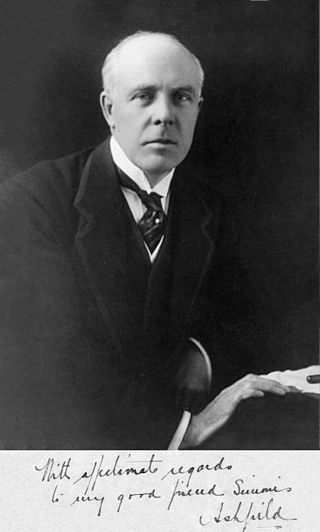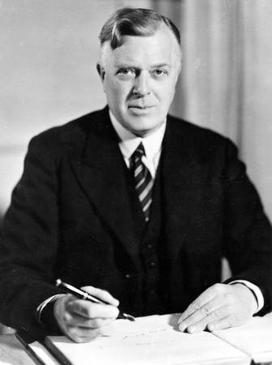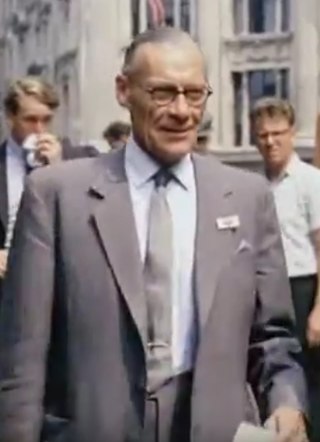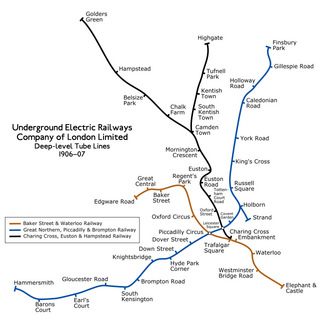
The London Underground is a rapid transit system serving Greater London and some parts of the adjacent home counties of Buckinghamshire, Essex and Hertfordshire in England.

The history of public transport authorities in London details the various organisations that have been responsible for the public transport network in and around London, England - including buses, coaches, trams, trolleybuses, Docklands Light Railway, and the London Underground.

Transport for London (TfL) is a local government body responsible for most of the transport network in London, United Kingdom.

The Greater London Council (GLC) was the top-tier local government administrative body for Greater London from 1965 to 1986. It replaced the earlier London County Council (LCC) which had covered a much smaller area. The GLC was dissolved in 1986 by the Local Government Act 1985 and its powers were devolved to the London boroughs and other entities. A new administrative body, known as the Greater London Authority (GLA), was established in 2000.

Albert Henry Stanley, 1st Baron Ashfield,, born Albert Henry Knattriess, was a British-American businessman who was managing director, then chairman of the Underground Electric Railways Company of London (UERL) from 1910 to 1933 and chairman of the London Passenger Transport Board (LPTB) from 1933 to 1947.

Frank Pick Hon. RIBA was a British transport administrator. After qualifying as a solicitor in 1902, he worked at the North Eastern Railway, before moving to the Underground Electric Railways Company of London (UERL) in 1906. He was chief executive officer and vice-chairman of the London Passenger Transport Board from its creation in 1933 until 1940.

The London Passenger Transport Board was the organisation responsible for local public transport in London and its environs from 1933 to 1948. In common with all London transport authorities from 1933 to 2000, the public name and brand was London Transport.
The London Transport Executive was the organisation responsible for public transport in Greater London, England between 1948 and 1962. In common with all London transport authorities from 1933 to 2000, the public name and operational brand of the organisation was London Transport.
London Regional Transport (LRT) was the organisation responsible for most of the public transport network in London, England, between 1984 and 2000. In common with all London transport authorities from 1933 to 2000, the public name and operational brand of the organisation was London Transport from 1989, but until then it traded as LRT. This policy was reversed after the appointment of Sir Wilfrid Newton in 1989, who also abolished the recently devised LRT logo and restored the traditional roundel.

London Country Bus Services was a bus company that operated in South East England from 1970 until 1986, when it was split up and later sold as part of the bus deregulation programme.
The transport system now known as the London Underground began in 1863 with the Metropolitan Railway, the world's first underground railway. Over the next forty years, the early sub-surface lines reached out from the urban centre of the capital into the surrounding rural margins, leading to the development of new commuter suburbs. At the turn of the nineteenth century, new technology—including electric locomotives and improvements to the tunnelling shield—enabled new companies to construct a series of "tube" lines deeper underground. Initially rivals, the tube railway companies began to co-operate in advertising and through shared branding, eventually consolidating under the single ownership of the Underground Electric Railways Company of London (UERL), with lines stretching across London.

Sir Alexander (Alec) Balmain Bruce Valentine OStJ MA, was Chairman of the London Transport Executive from 1959 to 1963 and Chairman of the London Transport Board from 1963 to 1965.

London TravelWatch is a statutory British consumer organisation that campaigns for improvements to transport in London. It deals with all complaints from passengers using any Transport for London modes including some cycling and pedestrian issues, Victoria coach station, passengers using Eurostar, the Heathrow Express rail service to Heathrow Airport and some aspects of rail travel including issues arising from the stations. It also deals with all rail complaints that are outside of the scope of the rail ombudsman and within its geographical remit. It is therefore in consumer representation terms an "appeals body". It is funded by the London Assembly and was established in its current form in July 2000.
The London Transport Executive was the executive agency within the Greater London Council, responsible for public transport in Greater London from 1970 to 1984. In common with all London transport authorities from 1933 to 2000, the public name and operational brand of the organisation was London Transport.

London Transport (LT) was the public name and brand used by a series of public transport authorities in London, England, from 1933. Its most recognizable feature was the bar-and-circle 'roundel' logo. With its origins in the Underground Electric Railways Company of London (UERL), the brand was first used by the London Passenger Transport Board (LPTB) to unify the identity of the previously separately owned and managed London Underground, Metropolitan Railway, bus and tram services. The London Transport brand was extended under the direction of Frank Pick to all aspects of transport operation including poster designs, tickets, train livery, seat upholstery and the station architecture of Charles Holden. When public transport operation was taken over by Transport for London (TfL) from London Regional Transport (LRT) in 2000, the London Transport brand was discontinued and replaced with Transport for London's own branding, which incorporates many features of the London Transport brand including the 'roundel' symbol and the Johnston font.
The Bus Reshaping Plan of 1966 was a plan devised by the London Transport Board for the reorganisation of bus routes in London, England. The main features of the plan, which was to be rolled out over ten to fifteen years, were:

The Underground Electric Railways Company of London Limited (UERL), known operationally as the Underground for much of its existence, was established in 1902. It was the holding company for the three deep-level "tube" underground railway lines opened in London during 1906 and 1907: the Baker Street and Waterloo Railway, the Charing Cross, Euston and Hampstead Railway and the Great Northern, Piccadilly and Brompton Railway. It was also the parent company from 1902 of the District Railway, which it electrified between 1903 and 1905. The UERL is a precursor of today's London Underground; its three tube lines form the central sections of today's Bakerloo, Northern and Piccadilly lines.
The London Tourist Board was established in 1963 and became the official regional tourist board for London under the Development of Tourism Act in 1969. It was responsible for the marketing and promotion of the capital, providing tourist information services, and recommending improvements to the infrastructure and facilities for the growth of tourism. In 2003, it was renamed Visit London. In 2011, it was put into administration by the Greater London Authority, and the tourism responsibility was transferred to a new company, London & Partners.
Sir Keith Bright was Chairman of London Regional Transport in the 1980s. He resigned following the Fennell Report into the King's Cross fire in 1988, that criticised the management of London Underground and London Transport.










